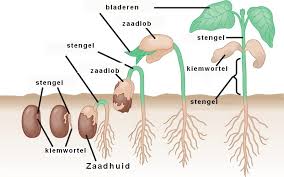Seeds should be stored cool and dry.
Some seeds lose their germination capacity after only one year. Others can survive in the soil for years without germinating. (They are the natural seed bank.)
 Permanently damp or wet soil makes the seeds rot. Make sure that there are adequate drainage holes at the bottom of your seed trays or pots.
Permanently damp or wet soil makes the seeds rot. Make sure that there are adequate drainage holes at the bottom of your seed trays or pots.
Preferably use 'fresh' seed, which has the highest germination power and -warranty. Mix older seed with some new seed (better seed vigor). Seeds of F1, F2 hybrids and others are not fertile.
(See also <Light - and cold starters>)
Still usable after some years:
potatoes (real seed) 5-7
strawberry 3-6
endive 3-4
asparagus 3-4
eggplants 3-5
beets 3-4
cauliflower 4-5
kale 4-5
beans 3-6
broccoli 4-5
cantaloupe 6-10
zucchini 6
angelica 1-2
peas 4-6
chervil 1-2
celeriac 4-5
cucumbers 5-7
cabbage 4-5 (broccoli, kale, cauliflower, Chinese cabbage, kohlrabi, Brussels sprouts)
rutabaga 3-5
kohlrabi 4-5
lovage 1-2
maize 4-6
mustard 5-8
Lambs quarter5
New Zealand spinach 4-5
okra 1-2
paprika 3
parsnip 1-3
peppers (all) 3-5
parsley 3-5
squash (all) 3-5
pumpkins 3-5
leeks 2-4
pick 5-8
radish 3-5
beetroot 5-6
salsify 3-4
celery 3-6
lettuce 3-4
Swiss chard -4
spinach 3-6
Brussels sprouts 4-5
sweetcorn 1-2
tomato 4-7
onions 2 (-4)
Corn salad 5-6
watermelon 4-6
chicory 4-5
carrots 3-5
sunflower 4-6
The seeds of Corn Poppy (Papaver rhoeas) store their germination power for decades. If the soil is disturbed, they come to the surface and bloom again the following year. That’s how bombs in WW I made Flanders Fields famous with poppies.
Some seeds can remain good for hundreds of years.
In 2006 Roelof van Gelder, historian and editor, found seeds in the National Archives in London. They were located in the archive for 203 years. They were hijacked by the English of a Dutch ship during the French Revolution. He allowed the seeds to germinate, it turned out to be an acacia -like.
Even 1,200 years old seeds of the Sacred Lotus (Nelumbo nucifera) are germinated. They were found in Manchuria (northern China).
Seeds of Canna compacta, found in an Inca ceremonial rattle - made from a 600 year old walnut germinated yet. In both cases, their age was determined by the C14 method.
A 2,000 year old date palm kernel was found at a depth of 20-40 meters along the banks of the Kolyma, a river in the north of Siberia, and could still germinate.
In Tel - Aviv a two thousand years in a clay pot kept seed of the since the year 500 of the globe vanished date palm was successfully planted by Elaine Solowey.
Svetlana Yashina and David Gilichinsky have managed to bring seeds of more than 30,000 years to life. It was safely stored in the Siberian permafrost after a squirrel had ever burried the seeds. It was the Silene stenophylla, a plant from the carnation family, which only occurs in Siberia.
